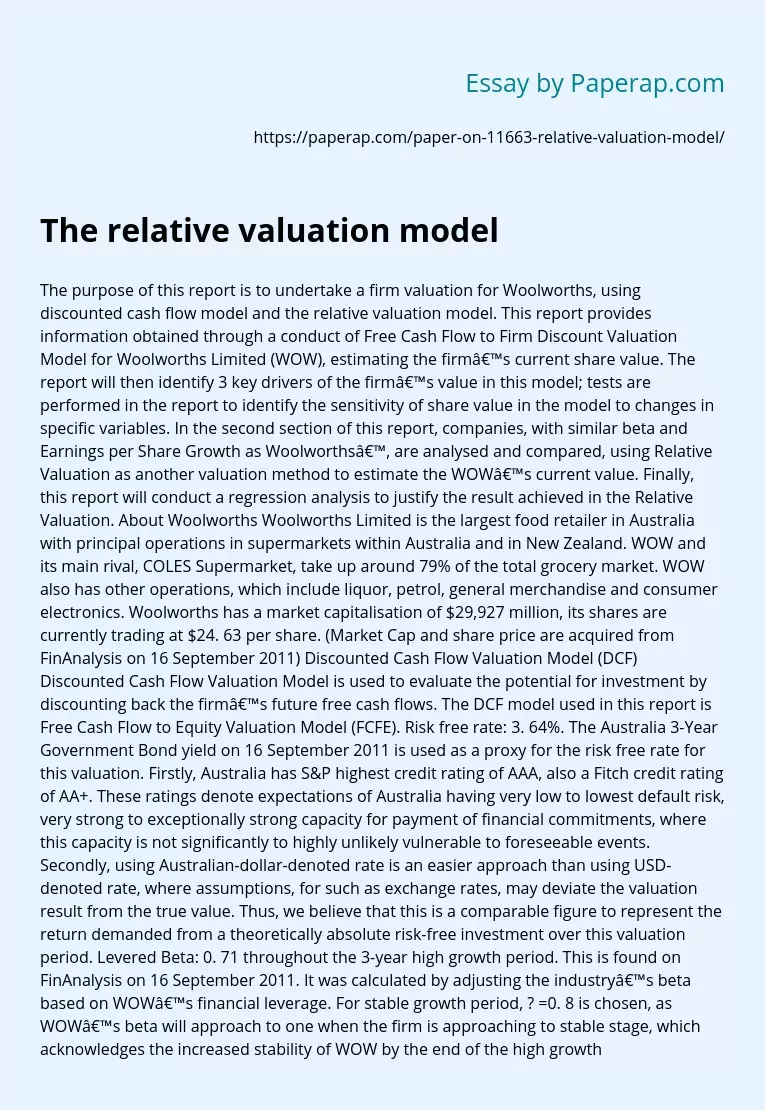The Relative Valuation Model
The purpose of this report is to undertake a firm valuation for Woolworths, using discounted cash flow model and the relative valuation model. This report provides information obtained through a conduct of Free Cash Flow to Firm Discount Valuation Model for Woolworths Limited (WOW), estimating the firm’s current share value. The report will then identify 3 key drivers of the firm’s value in this model; tests are performed in the report to identify the sensitivity of share value in the model to changes in specific variables.
In the second section of this report, companies, with similar beta and Earnings per Share Growth as Woolworths’, are analysed and compared, using Relative Valuation as another valuation method to estimate the WOW’s current value.
Finally, this report will conduct a regression analysis to justify the result achieved in the Relative Valuation. About Woolworths Woolworths Limited is the largest food retailer in Australia with principal operations in supermarkets within Australia and in New Zealand.
WOW and its main rival, COLES Supermarket, take up around 79% of the total grocery market. WOW also has other operations, which include liquor, petrol, general merchandise and consumer electronics. Woolworths has a market capitalisation of $29,927 million, its shares are currently trading at $24. 63 per share. (Market Cap and share price are acquired from FinAnalysis on 16 September 2011) Discounted Cash Flow Valuation Model (DCF) Discounted Cash Flow Valuation Model is used to evaluate the potential for investment by discounting back the firm’s future free cash flows. The DCF model used in this report is Free Cash Flow to Equity Valuation Model (FCFE).
Risk free rate: 3. 64%. The Australia 3-Year Government Bond yield on 16 September 2011 is used as a proxy for the risk free rate for this valuation. Firstly, Australia has S&P highest credit rating of AAA, also a Fitch credit rating of AA+. These ratings denote expectations of Australia having very low to lowest default risk, very strong to exceptionally strong capacity for payment of financial commitments, where this capacity is not significantly to highly unlikely vulnerable to foreseeable events.
Secondly, using Australian-dollar-denoted rate is an easier approach than using USD-denoted rate, where assumptions, for such as exchange rates, may deviate the valuation result from the true value. Thus, we believe that this is a comparable figure to represent the return demanded from a theoretically absolute risk-free investment over this valuation period. Levered Beta: 0. 71 throughout the 3-year high growth period. This is found on FinAnalysis on 16 September 2011. It was calculated by adjusting the industry’s beta based on WOW’s financial leverage.
For stable growth period, ? =0. 8 is chosen, as WOW’s beta will approach to one when the firm is approaching to stable stage, which acknowledges the increased stability of WOW by the end of the high growth period. Price sensitivity to change in stable growth rate, 1st key driver of the firm value: One of the key drivers of the firm value is the assumption for the stable growth rate. In our initial valuation, we assume that the firm’s stable growth rate will be approaching to Australian GDP growth rate as the firm achieves stability.
As presented, the estimated share value of WOW will increase as the stable growth rate increases. Price sensitivity to change in cost of equity during stable growth stage, 2nd key driver of the firm value: Another key driver of the value in the process of valuation is the cost of equity during stable growth stage. We initially assumed that the cost of equity will be 7. 64% as the beta of the firm will move towards one when the firm approaches stability. The estimated share price of the firm will decrease as the cost of equity during stable growth increases.
Price sensitivity to change in length of high growth, 3rd key driver of the firm value: In the last scenario, the assumption of length of high growth period has changed from the initial 3 years to 5 years. This could happen due to the recent financial breakdown, which would significantly slow down the growth of the firm. Should 5-year high growth be used, Australian 5-Year Government Bond rate of 3. 81% is chosen as the risk free rate for the model, as a result of which, the Cost of Equity during high growth and stable growth stages will change as presented below. Other factors stay constant, the estimated share price of WOW will be $26.
80, under which circumstances, the firm is undervalued given the current share price is $24. 63 on 16 September 2011. PS ratio is believed to be uniformly measured as all financial figures for the comparable firms are obtained from the current financial year at FinAnalysis. As these comparable firms are from different markets that have different accounting rules, Price to Sales (PS) ratio is chosen as the multiple to evaluate these comparable firms. Besides that, a similar financial leverage across these comparable firms gives us more of the reason to use PS ratio as the multiple.
The Relative Valuation Model. (2017, Dec 29). Retrieved from https://paperap.com/paper-on-11663-relative-valuation-model/

